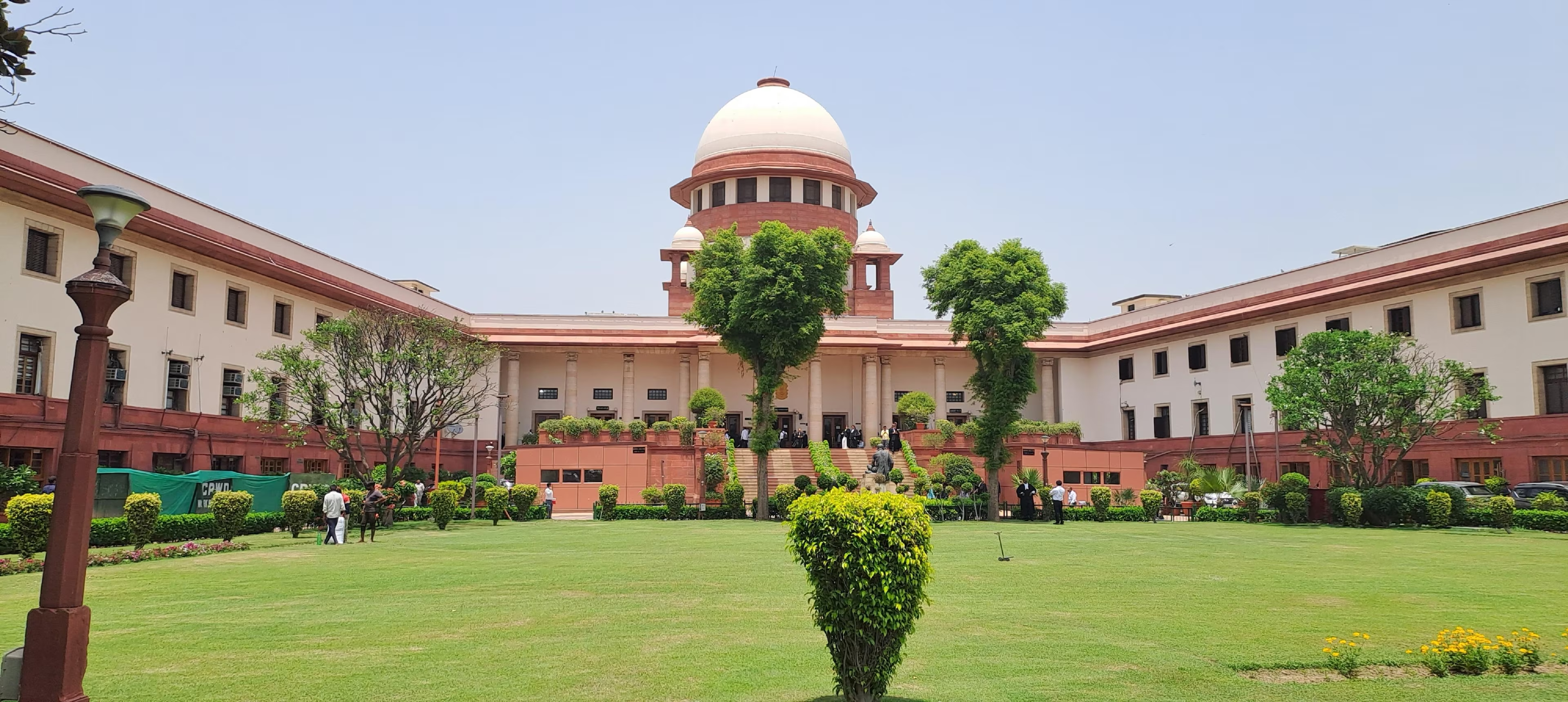-
In March 2025, the Supreme Court of India criticized the Uttarakhand government.
- The government failed to file an affidavit in a case about the misuse of CAMPA (Compensatory Afforestation Fund Management and Planning Authority) funds.
- These funds were meant for planting trees to compensate for deforestation.
- Deforestation = Cutting down trees.
- Afforestation = Planting trees to create new forests.
- However, these funds were misused to buy gadgets.
- The court said the matter is very important and SC ordered the government to submit the affidavit immediately.
CAMPA Act (Compensatory Afforestation Fund Act)
- The Compensatory Afforestation Fund Act (CAMPA) is a law in India that manages funds collected when forest land is diverted for non-forest purposes.
- The goal is to ensure that these funds are used efficiently and transparently for afforestation and forest conservation.
Background and History:
- Supreme Court’s Intervention (2002):
- In 2002, the Supreme Court of India noticed that funds collected for afforestation were being underutilized by the states.
- The Court ordered that these funds should be centrally pooled and managed by a special authority to ensure proper use.
- Creation of National CAMPA (2002):
- The National Compensatory Afforestation Fund Management and Planning Authority (National CAMPA) was set up to manage the centrally pooled funds for afforestation.
- State CAMPA (2009):
- In 2009, states created their own State CAMPA bodies.
- These State CAMPAs receive 10% of the funds from National CAMPA for use in afforestation and forest conservation at the local level.
- CAG Report (2013):
- In 2013, a CAG report revealed that the funds were still being underutilized despite the creation of National and State CAMPA bodies.
- Introduction of CAMPA Act (2015):
- To address the underutilization, the government introduced the Compensatory Afforestation Fund Act, 2015.
- The Act was presented in the Lok Sabha on May 8, 2015, for discussion.
- It was examined by a standing committee and passed in the Rajya Sabha on July 28, 2016.
Key Features of the CAMPA Act:
- Efficient Fund Utilization:
- The Act ensures that funds collected for afforestation are used in a transparent and efficient manner for their intended purpose.
- Central and State Authorities:
- The Act sets up a mechanism both at the Centre and in each State/Union Territory for better management of the funds.
- National CAMPA manages funds centrally, and State CAMPA manages local afforestation efforts.
- Accountability:
- The Act ensures accountability in how funds are used, making sure they are not diverted for unrelated purposes.
- Use of Funds:
- The funds collected through CAMPA are to be used for compensatory afforestation, forest conservation, and improvement of biodiversity.
|
CAG Report: Misuse of Funds (Feb 2025):
A report by the Comptroller and Auditor General (CAG), published on February 21, 2025, highlighted serious misuse of CAMPA funds by the Uttarakhand government.
- Misuse of Funds:
- The CAG report found that Rs 13.86 crore of CAMPA funds were misused.
- These funds were meant for planting trees but were spent on items like iPhones, laptops, refrigerators, coolers, and even building renovations.
- Problems with Afforestation:
- Delays: According to CAMPA rules, tree planting should happen within 1–2 years of receiving funds.
- However, the report showed that in 37 cases, the afforestation projects were delayed by more than eight years. This caused an extra cost of Rs 11.54 crore.
- Low Survival Rate: The survival rate of the planted trees was only 33.51%. This is much lower than the required survival rate of 60–65% set by the Forest Research Institute.
- Unsuitable Land for Afforestation:
- The report revealed that 1,204 hectares of land were not suitable for planting trees.
- However, the land was wrongly certified as suitable by the Divisional Forest Officers (DFOs).
- No action was taken against these officers for their mistakes.
CAG’s Recommendations:
The CAG made several recommendations:
- Better Financial Management: The government should set up stronger checks to prevent misuse of funds.
- Accountability: The officers responsible for the misuse of funds and delays in afforestation should face disciplinary action.
Impact and Significance:
- Environmental Impact:
- Misusing CAMPA funds harms the environment.
- Uttarakhand has critical forests for biodiversity and climate protection.
- Delayed afforestation and low tree survival rates harm these forests.
- Loss of Public Trust:
- When public money is misused, it undermines the trust that people have in the government.
- This is especially true when funds meant for the environment are wasted.
- Role of the Judiciary:
- The Supreme Court’s involvement shows the importance of judicial oversight.
- The court is making sure the government is held accountable for how public funds are used.
Comptroller and Auditor General (CAG) of India
- CAG is the head of the Indian Audit and Accounts Department.
- The CAG is known as the guardian of the public purse, responsible for auditing the finances of both the Centre and States.
- CAG ensures that public funds are used in line with the laws of the Constitution and Parliament.
- The CAG is one of the key pillars in the Indian democratic system, ensuring transparency and accountability in government finances.
Constitutional and Legal Provisions for CAG:
- Article 148:
- Appointment: The President appoints the CAG.
- Salary and Service Conditions: Decided by Parliament.
- Eligibility for Office: The CAG cannot hold any other office after leaving this position.
- Expenses Charged on the Consolidated Fund of India (CFI): All expenses related to the CAG’s office, including salary and pensions, are paid from the CFI.
- Article 149:
- The CAG performs duties and powers as prescribed by Parliament.
- Article 150:
- The CAG advises on the format of accounts for both the Centre and States.
- Article 151:
- The CAG submits its reports to the President for presentation in Parliament.
- Article 279:
- The CAG certifies the net proceeds of taxes or duties, and this certification is final.
- CAG’s (Duties, Powers, and Conditions of Service) Act, 1971:
- Tenure: 6 years or until the age of 65 years, whichever is earlier.
- Resignation: Can resign anytime by addressing a letter to the President.
- Removal: Can be removed in the same manner as a judge of the Supreme Court.
- Service Conditions: Salary and service conditions cannot be reduced to the disadvantage after appointment.
Duties and Powers of the CAG:
- CAG audits all accounts related to the Consolidated Fund of India, the Contingency Fund of India, and the public accounts of both the Centre and States.
- Audits accounts of government departments, local bodies, and other authorities when requested.
- CAG checks that all government expenditures are according to rules and regulations, ensuring there is no misuse of funds.
- Audits debt, sinking funds, deposits, and advances to ensure financial integrity.
- CAG advises the President on the format of accounts for the Centre and States.
- CAG submits its audit reports on central accounts to the President and those on state accounts to the respective state Governor.
Role of CAG in the Public Accounts Committee (PAC):
- Audit Reports: CAG submits three audit reports: Appropriation Accounts, Finance Accounts, and Public Undertakings.
- PAC Examination: These reports are examined by the Public Accounts Committee (PAC), which helps ensure government accountability, especially in terms of financial spending.
- Accountability and Checks: CAG works closely with PAC to ensure that financial rules are followed and corrective actions are taken when necessary.
- Interpreter Role: CAG acts as an intermediary, explaining technical financial matters to Parliament and translating politicians' concerns to the executive.
Difference Between the Office of CAG in India and Britain:
|
CAG in India
|
CAG in Britain
|
|
Acts only as Auditor General.
|
Acts as both Comptroller and Auditor General.
|
|
Audits accounts after expenditure is committed (ex post facto).
|
Money cannot be drawn without approval from the Comptroller.
|
|
CAG is not a member of Parliament.
|
CAG is a member of the House of Commons.
|
Challenges Faced by the Office of CAG in India:
- Limited Powers: CAG faces delays in obtaining information and cannot enforce its requests.
- Secret Service Expenditure: CAG is unable to inquire into certain secret service expenditures without relying on certificates from executive agencies.
- Lack of Clarity: There is debate over whether CAG can audit certain sectors like Public-Private Partnerships (PPP) and power distribution companies.
- Delays in Reports: The number of reports submitted by CAG has reduced significantly, affecting transparency.
- Conflict of Interest in Appointment: The current process for selecting CAG is seen as politically influenced.
|




